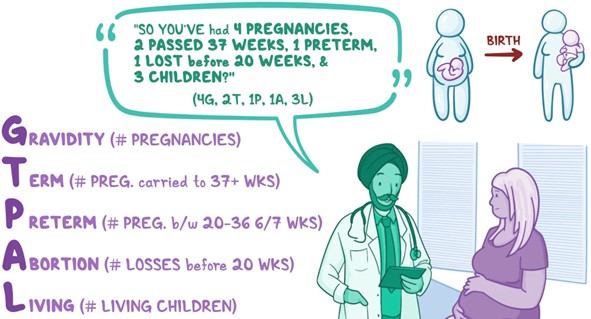A client at 39 weeks gestation is admitted in early labor. During the focused assessment, the practical nurse (PN) reviews the obstetrical history of the client who states that she has been pregnant five times but has only two living children, both of whom were full-term. The other three pregnancies were miscarriages during the first trimester. Which parity should the PN document for the term, premature, abortion, and living children (TPAL) for this client?
Term 2, Premature 0, Abortion 3, Living 2.
Term 6, Premature 3, Abortion 3, Living 2.
Term 2, Premature 1, Abortion 0, Living 3.
Term 3, Premature 0, Abortion 3, Living 2.
The Correct Answer is A
TPAL stands for Term, Premature, Abortion, and Living children, and it is used to document a client's obstetrical history.
In this case, the client has had a total of 5 pregnancies:
- Two pregnancies resulted in full-term (term) births, so the Term value is 2.
- Three pregnancies resulted in miscarriages during the first trimester (abortion), so the Abortion value is 3.
- The client has two living children, so the Living value is 2.
- There is no mention of any premature births, so the Premature value is 0.
Therefore, the appropriate documentation for this client's TPAL is Term 2, Premature 0, Abortion 3, and Living 2.

Nursing Test Bank
Naxlex Comprehensive Predictor Exams
Related Questions
Correct Answer is C
Explanation
This is the action that the PN should take if they believe that a prescription for a child is incorrect because the dosage prescribed is the usual adult dosage. Calling the healthcare provider and clarifying the prescription is the safest and most effective way to prevent medication errors and ensure the child's safety. The PN should not administer the medication until they are sure that it is correct and appropriate for the child.
Correct Answer is C
Explanation
A callus is a normal response of the body during bone healing, where new bone tissue forms around the fracture site to provide stability and support. It helps in the process of bridging the fracture and promoting healing.
The PN can provide reassurance to the client by explaining that the presence of a callus indicates that the bone is healing and progressing toward recovery. It is important to educate the client about the expected timeline for bone healing and the need for continued follow-up with the healthcare provider.
Incorrect:
A. Prepare to assist in applying a new cast to reduce pressure points: This choice assumes that the client's concern is related to discomfort or pressure points caused by the current cast.
However, the client's concern is about the formation of a callus, which is a normal part of bone healing. There is no indication that a new cast is necessary at this point.
B. Report the client's concern to the healthcare provider: While it's important to address client concerns and communicate any changes in their condition to the healthcare provider, in this case, the formation of a callus is an expected part of the bone healing process. It is not necessary to report this concern to the healthcare provider as it is a normal occurrence.
D. Teach the client strategies to prevent further calluses: The formation of a callus in this context is a natural response of the body to promote bone healing. It is not necessary to teach the client strategies to prevent further calluses, as callus formation is a temporary and beneficial part of the healing process.
Whether you are a student looking to ace your exams or a practicing nurse seeking to enhance your expertise , our nursing education contents will empower you with the confidence and competence to make a difference in the lives of patients and become a respected leader in the healthcare field.
Visit Naxlex, invest in your future and unlock endless possibilities with our unparalleled nursing education contents today
Report Wrong Answer on the Current Question
Do you disagree with the answer? If yes, what is your expected answer? Explain.
Kindly be descriptive with the issue you are facing.
